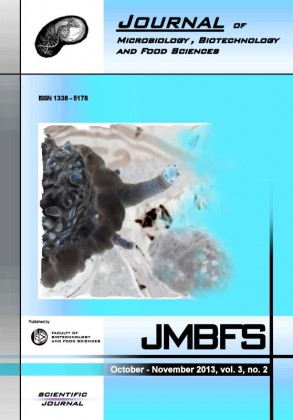SOLID-STATE FERMENTATIVE PRODUCTION AND BIOACTIVITY OF FUNGAL CHITOSAN
Keywords:
Fungal Chitosan, Solid-State Fermentation, corn straw, Bioactivity, BacteriaAbstract
Chitosan production was investigated using a laboratory-scale solid substrate fermentation (SSF) technique with four species of fungi: Penicillium expansum, Aspergillus niger, Rhizopus oryzae and Fusarium moniliforme.The peak growth for the organisms was after 16 days. Aspergillus niger had the highest growth with a maximal dry cell biomass of 15.8g/kg after 16 days cultivation on corn straw under solid substrate fermentation. This was closely followed by Rhizopus oryzae (14.6g/kg), Penicillium expansum (13.8g/kg) and Fusarium moniliforme (10.6g/kg) respectively. The fungus Rhizopus oryzae had the highest chitosan production with a maximum of 8.57g/kg in 16 days under solid substrate fermentation (SSF) with a medium containing corn straw. Aspergillus niger showed a modest chitosan yield of 6.8g/kg. Penicillium expansum and Fusarium moniliforme had low chitosan yields of 4.31g/kg and 3.1g/kg respectively. The degree of deacetylation of fungal chitosans ranged between 75.3-91.5% with a viscosity of 3.6-7.2 centipoises (Cp).Chitosan extracted from Rhizopus oryzae was found to have antibacterial activity on some bacterial isolates. At a concentration of 50mg/L, Rhizopus oryzae chitosan paralleled crab chitosan in susceptibility testing against some food-borne bacterial pathogens. Escherichia coli, Salmonella typhi, Pseudomonas aeruginosa and Bacillus subtilis showed inhibition rates of 83.2%, 67.9%, 63.8% and 62.4% respectively in response to 50mg/l Rhizopus oryzae chitosan in 24 h. The rate of inhibition (%) increased with increase in chitosan concentration.Downloads
Download data is not yet available.
Downloads
Published
2013-10-01
How to Cite
Aigbodion Omogbai, B., & Ikenebomeh, M. (2013). SOLID-STATE FERMENTATIVE PRODUCTION AND BIOACTIVITY OF FUNGAL CHITOSAN. Journal of Microbiology, Biotechnology and Food Sciences, 3(2), 172–175. Retrieved from https://office2.jmbfs.org/index.php/JMBFS/article/view/7063
Issue
Section
Microbiology
License
Copyright (c) 2013 Barry Aigbodion Omogbai, Marcel Ikenebomeh

This work is licensed under a Creative Commons Attribution 4.0 International License.
All papers published in the Journal of Microbiology, Biotechnology and Food Sciences are published under a CC-BY licence (CC-BY 4.0). Published materials can be shared (copy and redistribute the material in any medium or format) and adapted (remix, transform, and build upon the material for any purpose, even commercially) with specifying the author(s).

